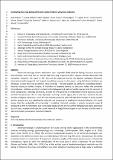Facilitating tree-ring dating of historic conifer timbers using Blue Intensity
View/
Date
02/2017Author
Grant ID
F/00 268/BG
NE/K003097/1
Keywords
Metadata
Show full item recordAbstract
Dendroarchaeology almost exclusively uses ring-width (RW) data for dating historical structures and artefacts. Such data can be used to date tree-ring sequences when regional climate dominates RW variability. However, the signal in RW data can be obscured due to site specific ecological influences (natural and anthropogenic) that impact crossdating success. In this paper, using data from Scotland, we introduce a novel tree-ring parameter (Blue Intensity – BI) and explore its utility for facilitating dendro historical dating of conifer samples. BI is similar to latewood density as they both reflect the combined hemicellulose, cellulose and lignin content in the latewood cell walls of conifer species and the amount of these compounds is strongly controlled, at least for trees growing in temperature limited locations, by late summer temperatures. BI not only expresses a strong climate signal, but is also less impacted by site specific ecological influences. It can be concurrently produced with RW data from images of finely sanded conifer samples but at a significantly reduced cost compared to traditional latewood density. Our study shows that the probability of successfully crossdating historical samples is greatly increased using BI compared to RW. Furthermore, due to the large spatial extent of the summer temperature signal expressed by such data, a sparse multi-species conifer network of long BI chronologies across Europe could be used to date and loosely provenance imported material.
Citation
Wilson , R , Wilson , D , Rydval , M , Crone , A , Büntgen , U , Clark , S , Ehmer , J , Forbes , E , Fuentes , M , Gunnarson , B E , Linderholm , H W , Nicolussi , K , Wood , C V & Mills , C 2017 , ' Facilitating tree-ring dating of historic conifer timbers using Blue Intensity ' , Journal of Archaeological Science , vol. 78 , pp. 99-111 . https://doi.org/10.1016/j.jas.2016.11.011
Publication
Journal of Archaeological Science
Status
Peer reviewed
ISSN
0305-4403Type
Journal article
Description
The Scottish pine network expansion has been an ongoing task since 2006 and funding must be acknowledged to the following projects: EU project ‘Millennium’ (017008-2), Leverhulme Trust project ‘RELiC: Reconstructing 8000 years of Environmental and Landscape change in the Cairngorms (F/00268/BG)’, the Native Oak and Pine project or ‘NOAP’ (Historic Scotland) and the NERC project ‘SCOT2K:Reconstructing 2000 years of Scottish climate from tree rings (NE/K003097/1)’. Further PhD funding for Milos Rydval is acknowledged from The Carnegie Trust.Collections
Items in the St Andrews Research Repository are protected by copyright, with all rights reserved, unless otherwise indicated.

